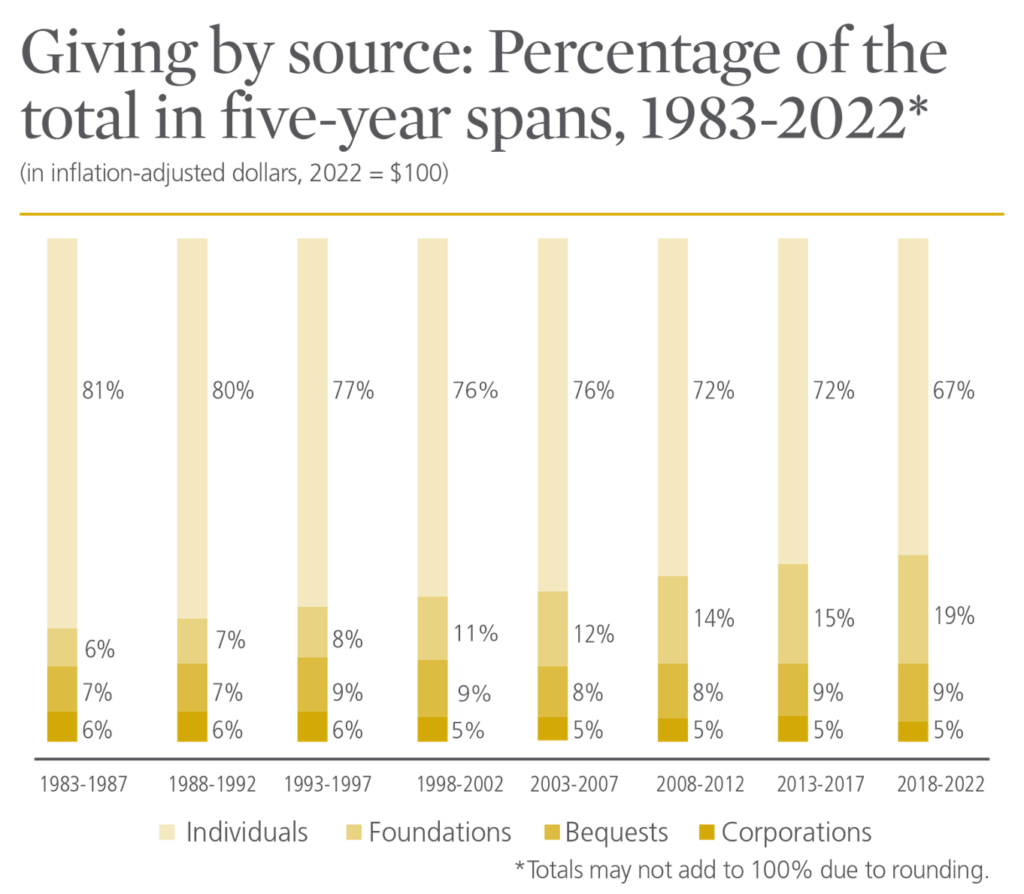Whether it’s our political landscape, financial landscape, or simply the tension felt across the globe, it’s no secret that this past year was a roller coaster of events. These events have impacted every American in one way or another.
In the aftermath of a global pandemic, economic uncertainty, and record high inflation rates, we wanted to explore how charitable giving shifted last year and its impact on nonprofit organizations.
The pandemic brought several challenges to charitable giving.
The challenges brought on by the pandemic, marked by a declining stock market, reduced disposable income.
High inflation rates presented new hurdles for financial generosity. Despite these difficulties, nonprofits demonstrated remarkable innovation during the pandemic. Their resilience and innovation amid hardships are proving valuable in navigating the ongoing financial instability.

Strategies, such as expanding online giving (as opposed to in-person), cultivating a future donor pipeline, sustaining existing donors, focusing on recurring giving and legacy giving, and incorporating new tools like AI, have been crucial for success in current giving landscape.
While 2022 and 2023 witnessed an overall decline in giving from the U.S. it’s crucial to consider this in context with the current financial and political landscape. The Russian invasion of Ukraine boosted international donations, totaling $499.33 billion in 2022.
2022 giving results follow the two best years on record for charitable giving. In 2021, giving to U.S. organizations surpassed $500 billion for the first time amid a global pandemic.
These figures reflect the enduring generosity and compassionate spirit of the American people.
Here are a few interesting findings from the Giving USA Report:
2022 Findings on Charitable Giving Trends
- Total charitable giving in the United States declined by 3.4 percent in 2022.
- Individual giving in 2022, totaling $319.04 billion, experienced a 6.4 percent decrease.

- The percentage of individual giving has dropped steadily over time, from 81% of total contributions in the five-year period of 1983-1987 down to 67% in 2018-2022.
- Overall charitable giving declined from $516.65 billion in 2021 to $499.33 billion in 2022, attributed to economic uncertainty.
- Mega-gifts by individuals reached $14 billion, representing about 5 percent of all individual giving for the second consecutive year.
- Foundation giving grew by 2.5 percent, totaling an estimated $105.21 billion in 2022.
- Legacy giving increased by 2.3 percent, reaching an estimated $45.60 billion.
- Corporate giving saw the strongest growth rate among the four sources, with an estimated increase of 3.4 percent, totaling $29.48 billion.
- Individual philanthropists remained a significant force, constituting 64 percent of all donations.
- Mega-gift donors played a consistent role, with the top 10 charitable gifts totaling nearly $9.3 billion.
- Corporate and foundation giving remained strong, with foundations accounting for 21 percent of total giving.
Early 2023 Charitable Giving Trends
- The Giving USA 2023 report saw giving trends that, as expected, showed declines. Due to the shifting economy, need is not as acute as it was during the pandemic.
- While total giving in current dollars has declined for the first time since 2009, in inflation-adjusted dollars, it remains comparable to pre-pandemic levels.
What These Giving Trends Mean For The Future
Despite economic challenges, donors have demonstrated adaptability and resilience, emphasizing the crucial role of nonprofits in addressing societal issues.
As we celebrate the generosity of 2022 and 2023, we hope the findings above help you to make informed decisions for your nonprofit fundraising strategy in 2024.
How Nonprofits can Innovate to Boost Giving Results in 2024
Show the impact of donor’s contributions.
In light of inflation and budget restrictions, donors are narrowing the list of organizations to whom they are giving. Be transparent with financial reports, and make sure you are communicating the difference they are making by choosing to give to your organization.
Another way to show this impact is through storytelling. Write down impactful stories to share. Interview volunteers or members of your organization who are on the front lines of this impact, and make sure your donors hear these stories through personal meetings, video, email, and/or social media.
Cultivate your future donor pipeline.
In 2024, email newsletters are vital to community engagement and cultivating new donors. Know your audience, and try to new things to expand your reach. Create new content for that audience you want to reach (or give your existing content a makeover). Try creating ads through Google For Nonprofits. Use lead generators to expand your email lists. Try out a new social media platform. Use paid ads to build email lists. Invite new people into your story, but be sure to keep them connected! Email newsletters are a great way to do that.
Sustain existing donors
Be sure your donors know just how grateful you are for their generosity. Send thank yous in a timely manner. Be personal, and get creative! What haven’t you tried? Try new ways of thanking donors through gifts, personal emails, or direct mail. Instant and automated thank you emails are great, but we also value going that extra mile for our donors. Most organizations fully rely on the generosity of their donors. Giving trends may show a decline in individual donations, yet your organization is still impacting the world for the better. Make sure your donors know how much they are appreciated!
Expand online giving
Can your donors easily give through your website? Create new avenues for your donors to give, such as SMS donations or through social media platforms.
Does your organization have a recurring gift option? This is a great way to keep donors engaged and feeling a part of your community!
What’s next for Canopy Life?
We’re building! Our Building Brave Capacity Campaign is going to transform our campus into an even better place for our students to learn, grow, and flourish, and the best part…we will be able to double our student population so more Kenyan students can benefit from Canopy Life Academy!
We are building a safe home for our students – where they can continue to learn in a safe environment, knowing without question that their mental, physical, spiritual, and emotional well-being matters.
Click below to see how Canopy Life is utilizing our strong community to fund this campus expansion in order to keep our current students all the way through high school.
